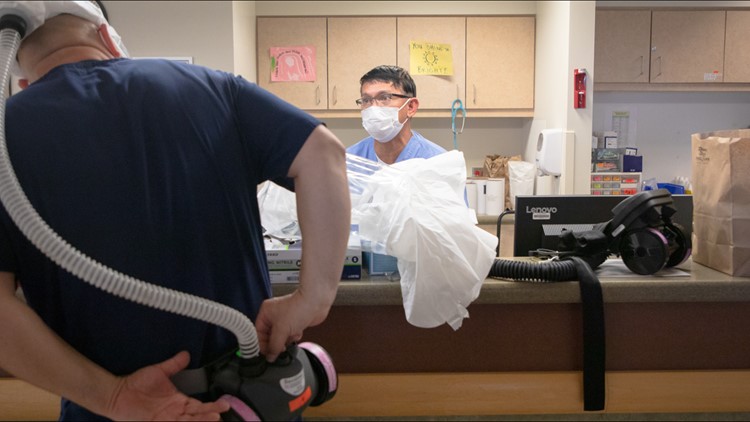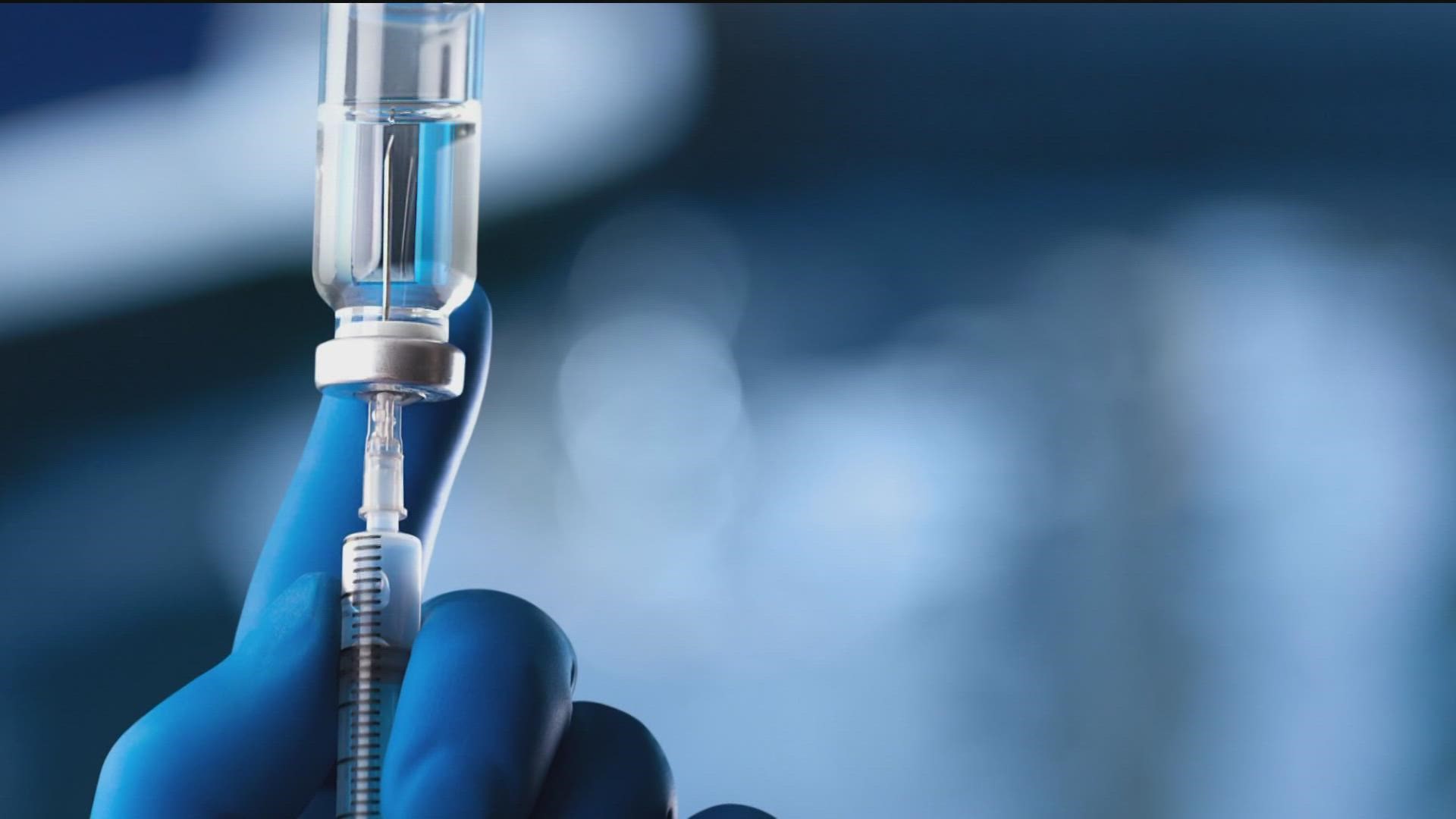SAN DIEGO COUNTY, Calif. — Inside the Sharp Chula Vista Medical Center on a recent Friday, nurse Richard Harchfield passed medical supplies through a sliding glass door. His colleagues in the isolation room were performing a battery of tests on a suspected COVID-19 patient while medical staff elsewhere in the hospital fought to keep alive 58 people stricken by the virus.
Upstairs, in the intensive care unit, doctors donned self-powered respirators to check on patients: One was strapped to a gurney that rotated to improve aeration in the lungs; another lay hooked up to a ventilator, sedated, with a small TV displaying a tranquil forest scene in a room no family members could visit.
Asked when COVID-19 cases peaked at the Sharp hospital, infection preventionist Cindy Stuart responded, “I feel like it’s happening right now.”

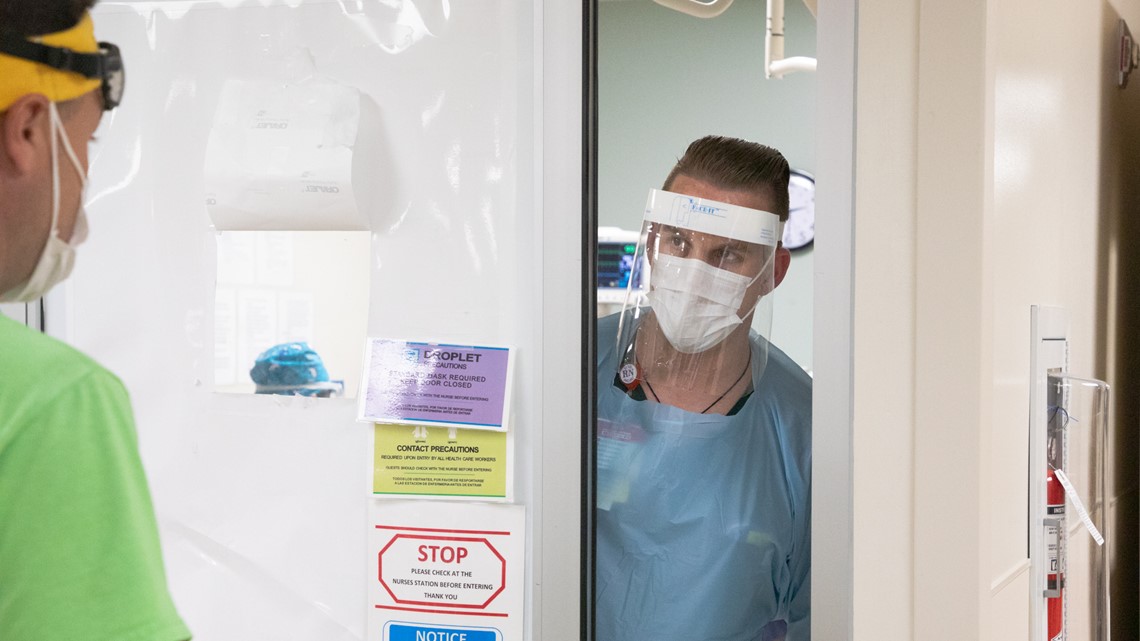
About a dozen miles north, outside the San Diego Hall of Justice that same Friday, hundreds of protesters gathered to urge Gov. Gavin Newsom to reopen the state. Signs read, “All Jobs are Essential” and “COVID-19 Socialism Unleashed.” A local radio host rallied the crowd with a bullhorn. A spa owner warned Newsom not to get a haircut once salons are allowed to operate again.
Scenes like those at Sharp and in downtown San Diego are playing out across the state and the country, where solutions for the economic devastation wrought by stay-at-home orders compete with the cautious approach urged by healthcare providers who want to save as many lives as they can.
Over the past several weeks, inewsource has interviewed San Diegans directly affected by COVID-19 to piece together a comprehensive picture of the harrowing tradeoff health officials must make: appease struggling citizens who are pushing for a return to normal or guard against an influx of cases in southern San Diego County that could devastate those communities.
This report was informed by time spent at the COVID-19 epicenter: The Sharp hospital caring for more coronavirus patients than anywhere else in the county. Reporters also spoke with a struggling small-business owner in San Marcos, a single mother in Imperial Beach unable to pay her rent and a recovered COVID-19 patient from National City worried about his wife's health. They interviewed doctors, nurses and hospital leaders trying to control hotspots in the South Bay.
About this report
As the coronavirus spreads across the U.S. and in San Diego County, so does uncertainty. To provide you with accurate in-depth reporting on the pandemic, KPBS and inewsource are collaborating in their news coverage.
To help tell this story, inewsource and KPBS created an interactive map that displays how vulnerable different parts of the county are to disasters such as COVID-19. It’s a stark visualization that shows the majority of those high-vulnerability areas lie between downtown San Diego and the Mexican border.
Despite how the spread of the virus is unfolding in the South Bay, county officials decided on Friday it was time to ease restrictions on local businesses, allowing some non-essential stores to reopen for curbside pickup. When questioned about whether the decision could cause a spike in COVID-19 cases in South County, Public Health Officer Dr. Wilma Wooten said the region overall meets state and federal criteria to move forward.
“We have to look at the entire region, not just one area,” Wooten said.
Taking risks
At high-risk for developing COVID-19 complications, Patty Mendoza thinks it’s too soon for the county to ease restrictions.
She earned just $400 in March with Ride Away, LLC, a non-emergency medical transport company, and was laid off in early April. Mendoza’s 17-year-old daughter, her rock, reassured her the small family would make it work. Her 9-year-old son offered the money he earned from recycling cans and bottles toward their $1,500 monthly rent in Imperial Beach.
A single mother without a job, she said she cries in the shower where her two children won’t see.
“I’m their mom. I’m supposed to be the strong one for them,” Mendoza said through tears. “Sometimes I feel like I’m not. Sometimes now I feel like I’m failing.”

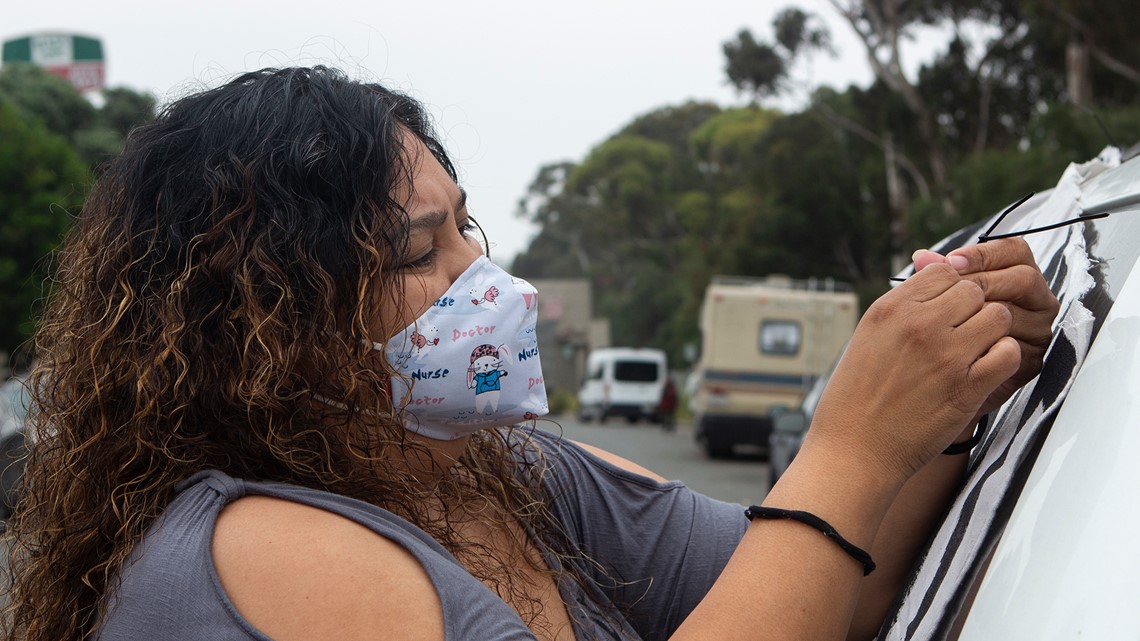
Mendoza grew up in Tijuana and moved as a child with her parents to the South Bay.
In general, Hispanics like Mendoza are nearly three times as likely to test positive for COVID-19 as someone who is white, and more likely to test positive than African Americans and Asians, according to an inewsource analysis of county data. The analysis also found the infection rate for Hispanics in the county is increasing more quickly than it is for any other race or ethnicity.
Mendoza is also considered at a higher risk for developing a severe illness, like pneumonia, from COVID-19 because she has asthma, a condition that recently cost her a potential job at a grocery store.
She said the store manager worried frequent interactions with customers would put her at risk and explained, “I don't want to give you this job because what if you don't go back to your kids?”
The 44-year-old can’t imagine getting to the point where she has to tell her kids they’ll soon be homeless. She hasn’t received her unemployment benefits or federal stimulus check yet, but she recently decided that getting a job would be too risky because of her health conditions and fears that in the coming weeks, with residents venturing out of their homes to parks or businesses, the risk will get higher.
“I think it’s too soon. I think there’s going to be another spike,” Mendoza said.
Ailments like asthma, diabetes and lung disease are clustered in the South County along with conditions that the U.S. Centers for Disease Control and Prevention says may affect that community’s “ability to prevent human suffering and financial loss in the event of disaster.” Those conditions include poverty, a lack of high school education, poor transportation options, single parent households and high percentages of minorities. Combined, those factors determine an area’s “social vulnerability” score, according to the CDC:
“We know that in disasters, the people on the margins of society are often the most impacted,” said Corinne McDaniels-Davidson, director of the Institute for Public Health at San Diego State University.
“And what I mean by margins of society are those of limited means or low socioeconomic status — older adults and racial and ethnic minorities,” she said.
How we created this map
For this story, a baseline map was built using 2018 social vulnerability data from the CDC combined with San Diego County shapefiles and racial profiles from the U.S. Census Bureau’s 2014-2018 American Community Survey.
For this story, a baseline map was built using 2018 social vulnerability data from the CDC combined with San Diego County shapefiles and racial profiles from the U.S. Census Bureau’s 2014-2018 American Community Survey.
McDaniels-Davidson pointed to the 1918 Spanish flu pandemic when the death rate from all causes among non-white populations was about 35% higher than among whites. Jumping ahead to the 2009 H1N1 outbreak, she found “minority populations had about 2½ to 3½ times higher rates of hospitalization compared to non-Hispanic whites.”
The same day protesters gathered downtown and Sharp Chula Vista medical staff made the rounds, Mendoza and her children joined dozens of others in a rent protest that began with a caravan of cars outside a parking lot in San Ysidro and ended more than 20 miles north in Linda Vista.


Wearing a mask, Mendoza hung makeshift banners on her white Honda Odyssey minivan.
“The people’s fight for a worthy life,” read one in Spanish. “Governor Newsom Cancel Rent/Mortgage,” said another.
“This is the story of my life right now,” Mendoza said. “This is something that was not my fault.”
“I didn't ask for this.”
Opening the door
Farther north, at the other end of the county, small-business owner Jeff McNeilly is also feeling the pinch — and he wants the county to let him reopen his shop.
By the time Newsom issued a stay-at-home order on March 19, McNeilly’s Big Frog Custom T-Shirts & More store in San Marcos was barely hanging on.
Though he would celebrate the store’s two-year anniversary in May, revenue was down around $20,000 in March, McNeilly said.
“Which is not a lot of money for many businesses, but for a small business like mine it's significant,” he said.
McNeilly, who said he has burned through much of his savings just getting the business started, determined the state’s order categorized his work as “non-essential.” The 58-year-old felt his only choice was to close the store and move to online and phone orders.
“I have no idea what the future looks like,” he said. “It’s just hard to fathom at this point.”


San Diego County’s unemployment rate was estimated to be 27% at the end of April. A recent survey of local businesses found 75% plan to furlough or lay off employees, temporarily shut down operations or permanently close.
McNeilly said we’re not “all in this together,” as people like to say.
“We might all be in the same storm, but we all have different pain, for sure.”
Near the end of April, county Supervisor Jim Desmond, whose district includes North County, called for some businesses to reopen. He cited the economic toll of COVID-19 and the fact that businesses like Costco have proven their ability to handle thousands of customers safely. Mayors from Carlsbad, Escondido, Oceanside, San Marcos and Vista joined him in urging the county to reopen businesses.
“We need to crack this door open. We need to start the economy going again,” Desmond said.
It’s not just closed businesses that have riled people.
Coronado Mayor Richard Bailey criticized county officials in a KUSI interview and op-ed in mid-April for closing off the oceans from recreational use.

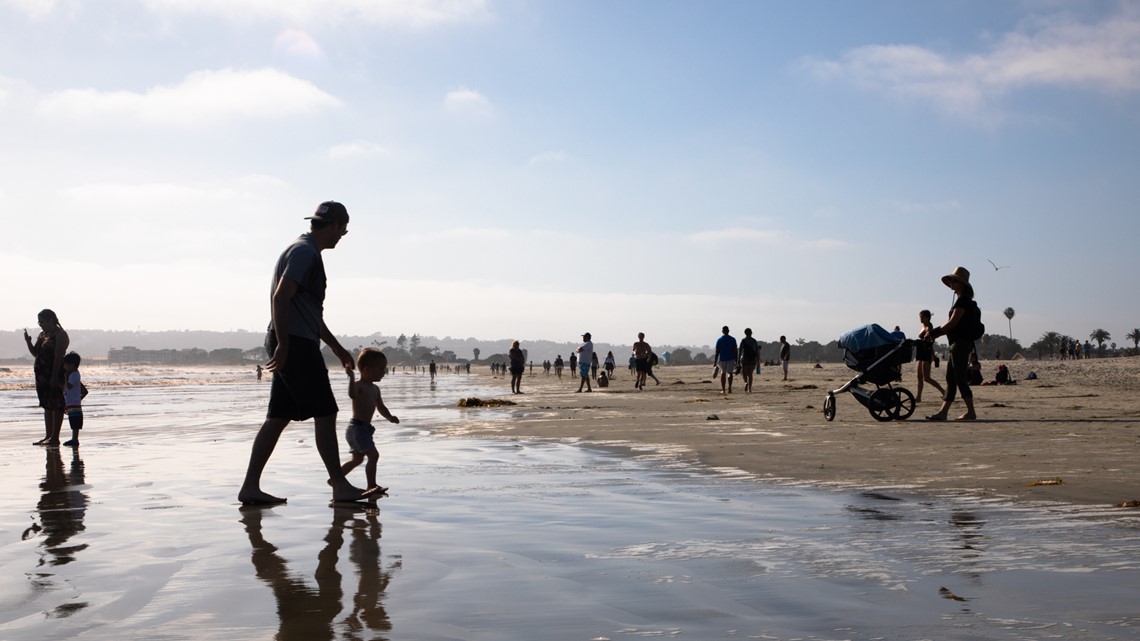
He called the orders an abuse of power.
“The public deserves to be treated with trust and respect,” he wrote. “Policies that are arbitrary, inconsistently applied, and criminalize harmless activities erode the public’s trust.”
By any metric, the county’s stay-at-home mandates have stifled the virus’s spread. A model developed by Dr. Natasha Martin, an infectious disease specialist at UC San Diego, estimates social distancing has saved 6,000 to 18,000 lives. Newsom lauded the county’s handling of COVID-19.
County officials have cautioned against a rapid return to normal, warning that lifting restrictions too quickly because people are antsy could cause an unmanageable surge in cases like those experienced in Singapore over the past month.
Instead, they’ve said they are basing decisions on a series of metrics outlined by state and federal authorities that indicate how much control the region has over the virus. Every weekday, Wooten, the public health officer, presents those numbers at a news conference to keep residents up to date.
On May 1, Wooten said the county had successfully met four of the federal government’s five criteria for reopening America, but added it’s not performing enough COVID-19 tests to meet the fifth.
“These criteria must be met before states and regions can proceed with a phased approach to open up,” she said.

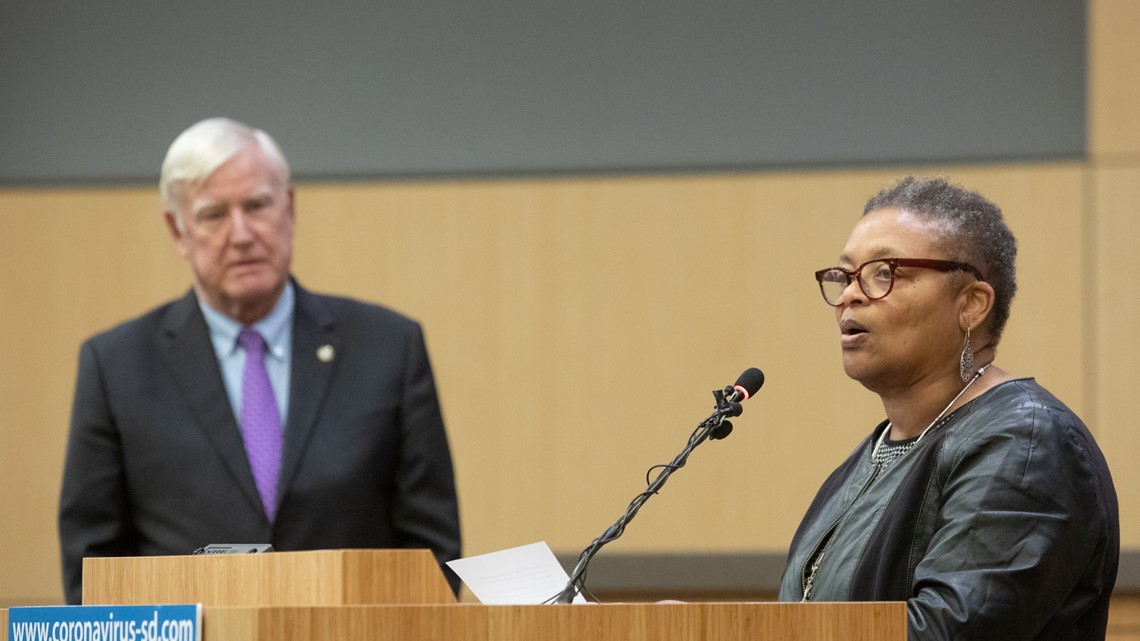
Four days later, the fifth criterion still unfulfilled, Wooten announced the county would be ready to start lifting restrictions within the next few days.
“Based on available data, we feel we are ready,” she said.
Wooten later explained that even though the region hadn’t met the federal guidelines on testing, it had met the state’s — conducting roughly 2,000 tests a day or more.
Under the new rules, which were created at the state level and recently enacted, some businesses — including bookstores, clothing stores and sporting good retailers — can reopen and offer curbside pickup to customers so long as they enforce social distancing and mask-wearing.
Wooten and others have emphasized that they are still watching COVID-19 metrics closely, and if they begin to see a surge in cases they might shut down the businesses again.
McNeilly, the T-shirt store owner, said he believes he can open up safely by following the rules the county has laid out for essential businesses like grocery stores — sanitizing the shop, asking customers to stay six feet apart and making sure everyone wears face coverings.
“People online are like, 'If you want to open up the economy, that means you want people to die,’” he said. “The arguments are just so extreme, and that's not the case at all. I want to open up and do it safely."
Keeping businesses closed forever is not an option, McNeilly said.
“It's just not going to work. At some point I'm going to have to pay my bills, and I don't have the income to do it.”
Flattening the curve
Inside Sharp Chula Vista Medical Center, registered nurse and infection preventionist Myra Laurino said she understands the frustration felt by McNeilly and others.
“There’s so many people not working right now,” and at some point we have to start the economy back up, she said.
“But we all want to do it in a safe manner, too.”
Laurino walked through the hospital’s ICU, which sounded like a wind tunnel as negative pressure ventilation ensured the virus didn’t escape the dozens of rooms set up to house COVID-19 patients.
Nearby, Dr. Alejandro Villegas looked through the glass at a 75-year-old patient and smiled.
“Twenty-five days on a ventilator and we extubated him yesterday,” Villegas said. “He’s actually transitioning out of the ICU today.”
One bright spot in an otherwise dark corner of San Diego County.


The hospitals Sharp and Scripps operate in Chula Vista have more COVID-19 patients than any other hospitals in the county, and the patients they test for the virus are more likely to test positive.
According to hospital officials interviewed in late April, Sharp Chula Vista was seeing roughly 20% of its patients test positive for COVID-19. At Scripps, the numbers ranged from 17% to 29%. Countywide, about 6% to 7% of tests come back positive each day.
What does that mean?
“Well, it means that we have an issue in the South County,” said Chris Van Gorder, CEO of Scripps Health.
Projections that Scripps provided to inewsource show the unequal impact the virus has had throughout the county: In its La Jolla and Encinitas hospitals, the number of COVID-19 hospitalizations are expected to zero out starting in July. But in Chula Vista, if more mitigation efforts don’t take place, the hospital anticipates a surge that will peak in September with about 300 COVID-19 patients at the same time.
Scripps has faced a continued growth in COVID-19 patients at its Chula Vista hospital over the past month and a recent spike in cases at its Mercy San Diego hospital in Hillcrest, where it’s transferring patients to free needed beds in the South Bay.
Sharp has also begun transferring COVID-19 patients from its Chula Vista hospital to Sharp Memorial in Kearny Mesa and Sharp Grossmont in La Mesa — all to make room for the continuing influx of new coronavirus patients in the South Bay.
Hospital safety precautions
With some ill people not going to the hospital when they need emergency care out of fear of contracting COVID-19, Sharp officials wanted to assure the public safety measures are in place at its facilities. They said staff is putting significant distance between COVID-19 patients and the rest of the hospital population in addition to many other preventative measures.
Dan Gross, who retired last month as Sharp HealthCare’s executive vice president but is continuing as a consultant, told inewsource he can’t say for sure why hospitalizations are so much higher in South County, but the region’s proximity to Mexico might be a factor.
“Tijuana is in crisis today,” Gross said, “in terms of their hospitals, in terms of the number of positive COVID patients.”
Gross and Van Gorder wrote a letter on April 28 to the U.S. Department of Health and Human Services about the situation.
“Any impression that we are flattening our curve ignores the threat south of the border,” they said.
“Providers in the San Diego region do not have adequate supplies to meet the projections we anticipate as a result of the increasing cases in our border communities.”
Scripps’ case numbers show that more than a third of patients who have visited its Chula Vista hospital since the beginning of March had recently traveled to Mexico, though it couldn’t determine where those patients contracted the virus. The day Van Gorder spoke with inewsource, he received a note from the county saying 11 ambulance runs had come from the border to county hospitals, and all of the patients were U.S. citizens.

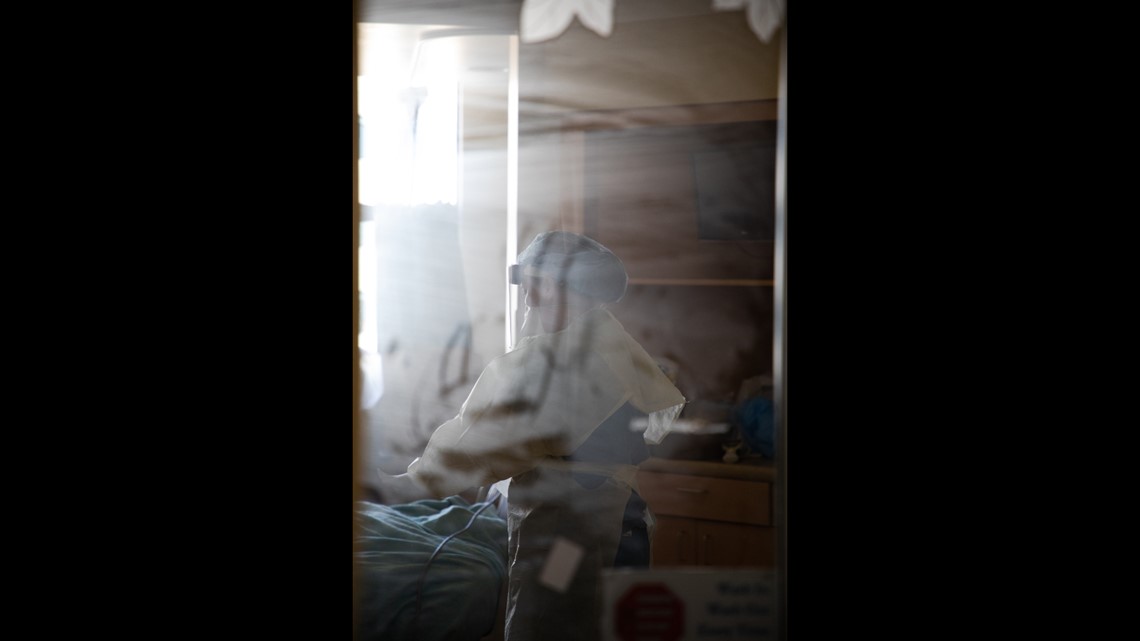
But the hospital executives are struggling to make sense of the statistics coming out of Mexico. The Mexican government has been slow to test residents, so the number of COVID cases may appear lower than they actually are. It’s also retroactively adding new COVID-19 positive tests to their data from people who contracted it days or weeks earlier, causing the numbers to change dramatically. Meanwhile, news stories reported a surge in cases at local hospitals that’s expected to continue in the coming weeks.
“I know many people have questioned, ‘What is the robustness and the accuracy of the data, and what is the strength of the infrastructure to truly capture all of the data under the current crises?” Gross said.
“That is indeed a question that is, I think, relevant and appropriate to be bringing forward,” he said.
In late April, the county said hospitals could resume elective surgeries, such as tumor removal surgeries and repairing dislocated joints. Elective surgeries, which are more profitable to perform than emergency care is, were put on hold at the start of the pandemic to save room for COVID-19 patients.
Van Gorder said Scripps hospitals are starting to offer those procedures again but are doing it carefully and slowly so they don’t use up too much protective medical gear and can watch out for a growth in COVID-19 cases — a growth he believes is inevitable once the county loosens restrictions.
“I think our elected officials must be under enormous pressure to reopen,” Van Gorder said. “And I understand the impact on the economy. I mean Scripps, like every healthcare system, is losing money right now as well, but my responsibility is health-related and I just want to make sure that whatever we do, we do it very cautiously.”
“I'll be really honest with you,” he said. “I'm glad I don't have to make those decisions.”
A matter of time
Raul del Toro thought he had a cold.
The 57-year-old National City resident recently lost his job at a hotel in downtown San Diego, he said. By mid-April he was delivering food to people in South County who were too afraid of contracting the virus to visit grocery stores. When he developed a fever and headache, he blamed the heavy rainfall and downed cold medicine at his wife’s behest.
As his symptoms grew worse, del Toro visited a clinic in Logan Heights where he tested negative for COVID-19. Days later, he was rushed to a hospital emergency room with a hernia and tested again. It was positive.
Del Toro quarantined himself in his house while his wife looked after him. But as his fever slowly improved, she became ill. On May 3, she tested positive for COVID-19.

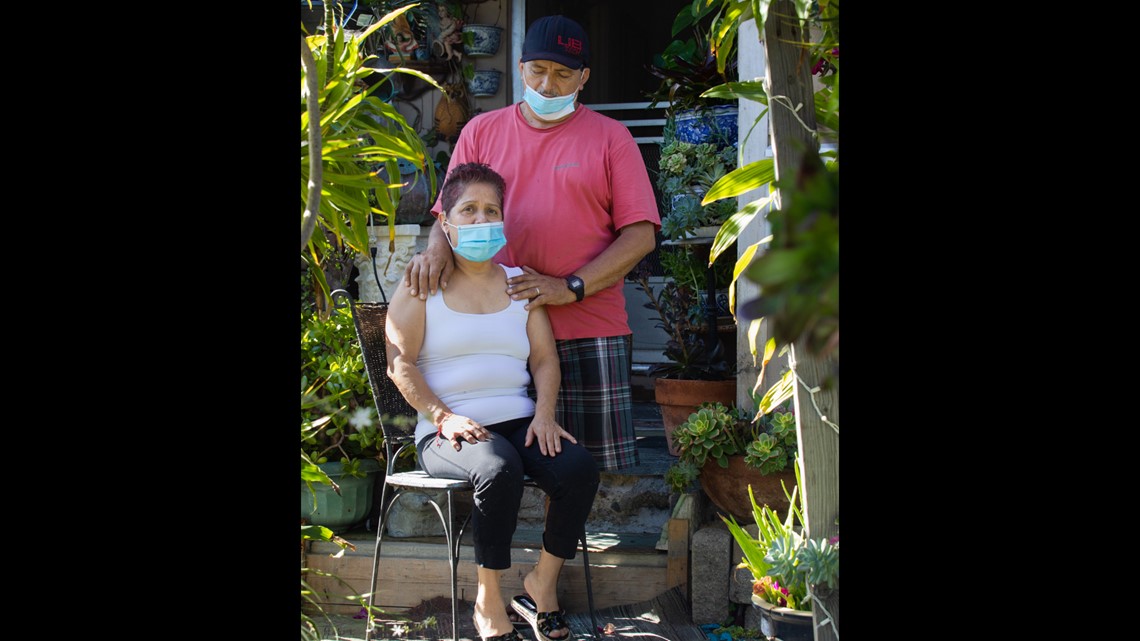
“She is small, very tiny. Her body is weaker, so she complains more that she is hurting, that she is more sensitive to everything,” he said in Spanish. “She doesn’t want to eat. I motivate her to eat more and tell her that her body will have more strength to overcome it. Everything is a matter of time, and your body starts to get over it.”
Del Toro won’t go back to delivering food — the risk of spreading the virus to others isn’t worth taking, he said. For now, he stays home, caring for his wife from a safe distance and disinfecting the house the best he can.
Born in Mexico but now a U.S. citizen, del Toro worries that National City residents are too eager to cross the border into Tijuana, where the virus is circulating quickly, and they aren’t taking the risk seriously enough. If the county’s stay-at-home restrictions are lifted, he said, even more people will catch it.
“It’s too fast because every day there’s more cases,” del Toro said. “People think this is over, and people are not taking the precautions needed. If people don’t wait a bit longer, this is going to get even worse.”
National City was the first municipality in the county to require face coverings in public, followed days later by Chula Vista. The leaders of South County cities have called out the county and state for neglecting their residents as cases rise and testing lags.
Chula Vista Mayor Mary Salas told inewsource she attributes her city’s growing numbers to its socioeconomic disparities and high volume of essential workers.
“They’re working out of necessity, and they’re also working because we continue to demand their services,” Salas said. Sanitation, healthcare and restaurant workers are still moving about, she said.
Salas’ family has lived in the South Bay for more than 100 years. With a population topping a quarter-million people, more than half of them Hispanic, her city is reeling from COVID-19.
“Certainly our poorest communities are more severely impacted, and that’s been historically the case,” said Salas.
The mayor dreads reading the daily tallies of new deaths and infections in her community.
“Is this going to level off? Can we see a drop?” she asked in late April as she reviewed the numbers. “But so far, that’s not happening.”
When asked this week about the high rate of COVID-19 infections among Hispanic people, Wooten, the county public health officer, said, “I really don’t think much should be read into that.”
Wooten also said the county is adding more testing sites in vulnerable communities. It opened a new location in Chula Vista last week that doesn’t require a doctor’s referral.
Even so, the county is far from meeting its goal. As of Friday, San Diego County was reporting results from 3,572 COVID-19 tests. Its target, based on Harvard University estimates, is 5,200 tests a day.

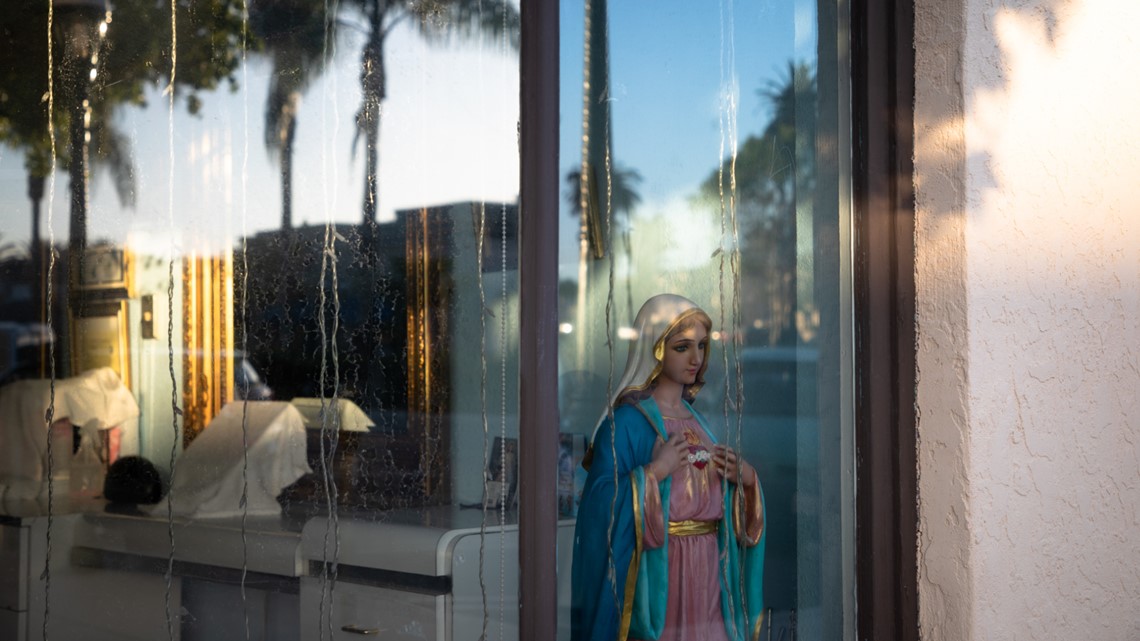
While the county has cited a downward trend in the number of positive COVID-19 tests as justification for reopening, Chula Vista’s numbers are still climbing.
On Friday, the city reopened its parks and trails for passive use.
Salas said her community is coming together, with residents doing their best to volunteer and share their resources. A local landscaper donated 200 plants for residents, she said, so when she goes on food donation runs, she drops off a plant.
“The food to nourish their bodies, the plants to remind them that we do live in a beautiful world,” she said.
“And we are going to appreciate that world more than ever once we climb out of this.”
inewsource staff member Carla Sánchez contributed to this story.


